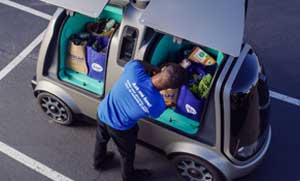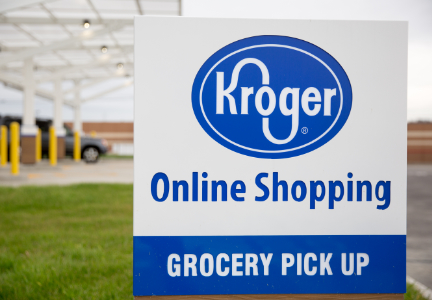CINCINNATI – The Kroger Co.’s strategy to build a long term omnichannel retail model crashed headlong into Wall Street’s short-term earnings expectations when its second-quarter results were released Sept. 13. The retailer’s share price fell more than 9 percent in trading that day because its sales did not meet investor’s expectations.
Kroger’s vision can be summed up in three words – anything, anytime, anywhere. The retailer is building a model that will give it the capabilities to engage and work with consumers across a variety of platforms. The company’s Restock Kroger program is designed to reposition its core business by 2020.
“You can see this through our exclusive arrangements to bring Ocado's smart platform to the US; and in our recent launch of Ship, Kroger's new direct- to-customer shipping platform; and in our continued expansion of home delivery, including our driverless delivery tests with Nuro,” said William Rodney McMullen, chairman and CEO, during a conference call with analysts Sept. 13. “You can also see this in our merger with Home Chef. Part of what makes our merger so exciting is their data-driven and customer-centered approach to menu creation and meal solution development. Home Chef is accelerating our ability to deliver convenience, simplicity and a personalized food experience.”
to-customer shipping platform; and in our continued expansion of home delivery, including our driverless delivery tests with Nuro,” said William Rodney McMullen, chairman and CEO, during a conference call with analysts Sept. 13. “You can also see this in our merger with Home Chef. Part of what makes our merger so exciting is their data-driven and customer-centered approach to menu creation and meal solution development. Home Chef is accelerating our ability to deliver convenience, simplicity and a personalized food experience.”
All the initiatives offer benefits for Kroger, but they also require investment. It was such investments and the company’s private label pricing initiative that hindered the company from meeting Wall Street expectations.
“…we accelerated several planned Restock Kroger investments starting in the first quarter and continuing during the second quarter,” said John Michael Schlotman, CFO. “These include investments in price, especially in support of Our Brands, and in space optimization. Our pricing strategy isn't new. Since 2000, we have invested more than $4.2 billion in lower prices for our customers, while also striving to provide the best full-service grocery experience in America.”
McMullen said Kroger’s private label brands made up 28.2 percent of unit sales and 25.6 percent of sales dollars, both of which are record results for a second quarter. He added that digital sales grew by more than 50 percent during the quarter.
 “We’re executing our digital strategy and growing our seamless coverage area, which now reaches more than 80 percent of our customers, up from 75 percent in the first quarter,” he said. “This includes our network of ClickList pickup locations; stores offering home delivery through Instacart and other partners; and ship-to-home capabilities, such as our new Kroger Ship platform.”
“We’re executing our digital strategy and growing our seamless coverage area, which now reaches more than 80 percent of our customers, up from 75 percent in the first quarter,” he said. “This includes our network of ClickList pickup locations; stores offering home delivery through Instacart and other partners; and ship-to-home capabilities, such as our new Kroger Ship platform.”
Schlotman said the retailer expects sales, excluding fuel, to rise between 2 percent and 2.5 percent in fiscal 2018. Kroger raised its earnings guidance to $3.88 to $4.03 per share in fiscal 2018 from $3.64 to $3.79. The increase is due to an unrealized gain in Ocado shares recorded in the second quarter, according to the company.
“If you look at the midpoint of our guidance range today, that's a little over 6 percent earnings-per-share growth rate, which I think is a very respectable result in an environment where we're making dramatic investments to reshape the future of the company,” he said. “I think the management team here at Kroger is proud of being able to refocus our future efforts and still deliver on the bottom line for shareholders.”

